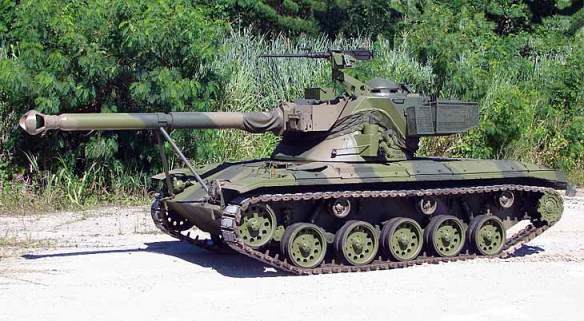
SK 105, also known as Kürassier, was developed from 1965 by Saurer-Werke, taken over by Steyr-Daimler-Puch in 1970, to meet the requirements of the Austrian Army for a mobile antitank vehicle.
First prototype was completed in 1967 with pre-production vehicles following in 1971.
Driver sits front left, turret centre, engine and transmission rear. Oscillating turret is an improved French Fives-Cail Babcock FL-12 in which 105mm gun is fixed on upper part, commander left, gunner right. The 105mm gun is fed by two revolver-type magazines, each of which holds six rounds. Ammunition fired includes HE, HEAT and smoke, but with modifications SK 105 also fires APFSDS projectiles.
Turret traverse and elevation is powered, manual controls for emergency use, turret traverse 360°, 105mm gun in upper part of turret elevates from -8° to +12°.
Photo of the SK105A3 at the M60-level turret armour, M68 gun with fully stabilized autoloader for 10-12 rpm ROF, two-plane stabilization, thermal optics, laser rangefinder, and digital FCS.
There are three light tank variations of the SK-105 in service; export customers such as Argentina, Bolivia, Morocco, and Tunisia mostly use the SK-105/A1; the SK-105/A2 is the version most commonly encountered in Austrian service; and the SK-105/A3 was the newest version, in limited production. In addition, appliqué armor of the same capabilities as that available for the AMX-13 is available for the SK-105 (however, an AMX-13 kit will not fit the SK-105 and vice versa).
Pionier engineering vehicle “Pionierpanzer A1”
VARIANTS
The SK 105/A1 production models were ultimately upgraded to the new SK 105/A2 standard to which the fire control system (FCS) was replaced and a fully-automatic reloading system implemented for the main gun. The main gun was now stabilized for firing “on the move”. The SK 105/A3 mark was a proposed prototype form featuring an all-new oscillating turret design as well as increased armor. This vehicle would have fielded the American M68 105mm main gun which allowed for firing of NATO-standard projectiles. The chassis went on to serve in three distinct though related production forms as the “Greif” ARV (Armored Recovery Vehicle with hydraulic crane, winch and dozer blade), the “Pionier” CEV (Combat Engineering Vehicle) and the SK-105 “Fahrschulpanzer”, a turretless trainer derivative.
Since its inception, the SK 105 has gone on to see operational service with the forces of Argentina, Austria, Bolivia, Botswana, Brazil, Morocco and Tunisia in limited numbers. Austria, by far, made up the largest collection of operational SK 105s numbering some 286 examples in service at peak. In all, some 716 SK 105 tanks went on to be produced. The Austrian Army has since given up use of the SK 105 series.
Specifications
Mass 17.7 tonnes (19.5 short tons; 17.4 long tons)
Length 5.58 metres (18 ft 4 in) 7.76 m (25 ft 6 in) w/ main gun
Width 2.5 m (8 ft 2 in)
Height 2.88 m (9 ft 5 in)
Crew 3
Armor base: 8 mm (0.31 in) maximum: 40 mm (1.6 in)
Main Armament SK-105A2: 105 mm CN105G1 rifled gun
Secondary Armament 7.62×51mm NATO co-axial machine gun
Engine Steyr 7FA / 6-cylinder diesel engine 320 hp (238 kW)
Suspension torsion bar, 5 road wheels
Operational range 500 kilometres (310 mi)
Maximum speed 70 km/h (43 mph)